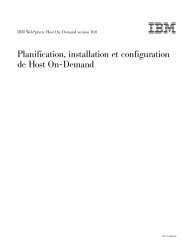Pianificazione, installazione e configurazione di Host On-Demand
Pianificazione, installazione e configurazione di Host On-Demand
Pianificazione, installazione e configurazione di Host On-Demand
Create successful ePaper yourself
Turn your PDF publications into a flip-book with our unique Google optimized e-Paper software.
Nota: La <strong>di</strong>rectory ed il nome <strong>di</strong> file devono già esistere.Per creare il proprio file <strong>di</strong> risposte, immettere le seguenti opzioni:-options-record nomefiledove nomefile è il nome del file <strong>di</strong> risposte.Per le altre opzioni <strong>di</strong> <strong>installazione</strong>, consultare l’Appen<strong>di</strong>ce D, “Opzioni <strong>di</strong> rigacoman<strong>di</strong> dell’utilità <strong>di</strong> avvio della piattaforma nativa”, a pagina 199.Installazione in OS/2Se si sta eseguendo l’aggiornamento e si è mo<strong>di</strong>ficato /hostondemand/private/NSMprop oppure mo<strong>di</strong>ficato o creato /hostondemand/hod/config.properties,bisogna eseguire il backup <strong>di</strong> questi file prima dell’<strong>installazione</strong> e ripristinarliquin<strong>di</strong> dopo l’<strong>installazione</strong>. Questi file verranno sovrascritti durante il processo <strong>di</strong>decompressione.Le operazioni <strong>di</strong> seguito riportate presumono che hostondemand sia la <strong>di</strong>rectory delserver e HOD la <strong>di</strong>rectory <strong>di</strong> pubblicazione. Per installare il server <strong>di</strong> <strong>Host</strong><strong>On</strong>-<strong>Demand</strong>:1. Inserire il CD.2. Creare una <strong>di</strong>rectory del server, ad esempio hostondemand. La <strong>di</strong>rectory delserver contiene i file utilizzati solo dal server e non deve essere <strong>di</strong>sponibileper le stazioni <strong>di</strong> lavoro client.3. Passare alla <strong>di</strong>rectory del server.4. Eseguire il seguente comando per estrarre i file:unzip [cd_rom]:\zip\hod10srv.zipdove:v unzip è il programma <strong>di</strong> spacchettamento (ad esempio UNZIP.EXE ). Taleprogramma deve supportare nomi file lunghiv [cd_rom] è la lettera dell’unità CD-ROMv zip è la <strong>di</strong>rectory sul CD5. Creare la <strong>di</strong>rectory <strong>di</strong> pubblicazione; ad esempio, HOD. La <strong>di</strong>rectory <strong>di</strong>pubblicazione contiene i file che devono essere <strong>di</strong>sponibili agli utenti del clientche accedono al server me<strong>di</strong>ante un browser.6. Passare alla <strong>di</strong>rectory <strong>di</strong> pubblicazione.7. Eseguire il seguente comando per estrarre i file:unzip [cd_rom]:\zip\hod10www.zip8. Rendere la <strong>di</strong>rectory <strong>di</strong> pubblicazione <strong>di</strong>sponibile ai client sulla rete.Consultare la documentazione del server Web per informazioni su comeeseguire quest’operazione.9. Configurare un host locale aggiungendo la seguente riga al file setup.cmdcontenuto generalmente nella <strong>di</strong>rectory \mptn\bin:ifconfig lo 127.0.0.110. Avviare <strong>Host</strong> <strong>On</strong>-<strong>Demand</strong> Service Manager, che fornisce i servizi <strong>di</strong> supportoper <strong>Host</strong> <strong>On</strong>-<strong>Demand</strong> e funziona come un’applicazione Java:a. Dalla richiesta coman<strong>di</strong>, passare alla <strong>di</strong>rectory \hostondemand\lib.b. Copiare NCServiceManager-OS2.cmd dalla <strong>di</strong>rectory \hostondemand\lib\samples\CommandFiles.72 IBM WebSphere <strong>Host</strong> <strong>On</strong>-<strong>Demand</strong> Versione 10.0: <strong>Pianificazione</strong>, <strong>installazione</strong> e <strong>configurazione</strong> <strong>di</strong> <strong>Host</strong> <strong>On</strong>-<strong>Demand</strong>






